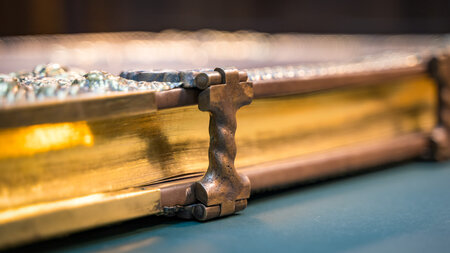Eintrag in der Universitätsbibliographie der TU Chemnitz
Volltext zugänglich unter
URN: urn:nbn:de:bsz:ch1-qucosa-227357
Liu, Yu
Qu, Qunting (Prof. Dr.) (Gutachter)
Aqueous Rechargeable Batteries with High Electrochemical Performance
Kurzfassung in deutsch
Mit der Entwicklung der Weltwirtschaft steigt der Energieverbrauch weiterhin stark an. Darüber hinaus reduzieren sich die nicht erneuerbaren Energiequellen, wie Öl, Erdgas und Kohle und die Umweltverschmutzung wird größer. Daher soll die Energienutzung in eine neue, erneuerbare und umweltfreundliche Richtung gehen. Die Arbeit hat zum Ziel innovative, wässrige Akkumulatoren zu entwickeln.Im Allgemeinen können wässrige Akkumulatoren gemäß der Elektrolyte in drei verschiedenen Kategorien eingeteilt werden. Es gibt feste, organische und wässrige Elektrolyte einschließlich saurer, alkalischer und neutraler. In Bezug auf metallbasierte negative Elektroden können sie auch als Lithiumbatterie, Natriumbatterie sowie Magnesiumbatterie etc. bezeichnet werden. Daher werden im ersten Kapitel einige typische Akkumulatoren, wie die Lithiumionenbatterien, Daniell-Element, Weston-Zelle, Nickel-Cadmium-Batterie und Bleibatterie vorgestellt.
Im Vergleich zu organischen Elektrolyten wurden wässrige Akkumulatoren aufgrund ihrer billigen, leichten und sicheren Bauweise in den letzten Jahren umfassend untersucht. Zusätzlich dazu ist die ionische Leitfähigkeit von wässrigen Elektrolyten um zwei Größenordnungen höher als die von organischen Elektrolyten. Dies garantiert eine hohe Entladungsrate für wässrige wiederaufladbare Batterien. Somit bieten wiederaufladbare Batterien potentielle Anwendungen in der Energiespeicherung und -umwandlung.
Allerdings verursachen starke Säuren oder Basen, die als Elektrolyte für sekundäre Batterien eingesetzt werden, eine starke Korrosion. Somit wären neutrale wässrige Elektrolyten (oder Elektrolytlösungen) mit einem pH-Wert in der Nähe von sieben, wie zum Beispiel schwach basisch oder sauer, die beste Wahl für wässrige Akkumulatoren. Aktive Elektrodenmaterialien der Batterien, die hochgiftige Schwermetalle wie Blei, Quecksilber und Cadmium enthalten, belasten die Umwelt.
Um die Menge an Schwermetallen und Säure (oder Basen) zu verringern, sowie die spezifische Kapazität von Batterien zu erhöhen, untersucht diese Dissertation vor allem die elektrochemische Leistung der PbSO4/0,5M Li2SO4/LiMn2O4-Zelle, der Cd/0,5M Li2SO4+10mM Cd(Ac)2/LiCoO2-Zelle und von C/Cu/CNT-Gemischen als negative Materialien in 0,5 M K2CO3?Elektrolyt-Halbzellen. Die zugehörigen experimentellen Ergebnisse werden wie folgt zusammengefaßt:
Im Kapitel 3 wurde eine säurefreie Bleibatterie auf Basis des LiMn2O4-Spinells als positive Elektrode, PbSO4 als negativer Elektrode und der wässrigen Lösung von 0,5 M Li2SO4 als Elektrolyt zusammengesetzt. Die spezifische Kapazität auf Basis von LiMn2O4 beträgt 128 mA?h?g-1 und die durchschnittliche Entladungsspannung beträgt 1,3 V. Die berechnete Energiedichte ist 68 W?h?kg-1, bezogen auf die praktischen Kapazitäten der beiden Elektroden. Diese Ergebnisse zeigen, dass die positive Elektrode der Bleibatterie (PbO2) vollständig durch umweltfreundliches und billiges LiMn2O4 ersetzt werden kann, wodurch 50 % des Bleis eingespart werden können. Außerdem wird Schwefelsäure nicht benötigt.
Kapitel 4 zeigt eine wässrige wiederaufladbare Lithiumionenbatterie, die metallisches Cadmium als negative Elektrode, LiCoO2-Nanopartikel als positive Elektrode und eine wässrige, neutrale Lösung von 0,5 M Li2SO4 und 10 mM Cd(Ac)2 als Elektrolyt enthält. Die durchschnittliche Entladungsspannung beträgt 1,2 V und die spezifische Entladungskapazität beträgt 107 mA?h?g-1 auf Basis von LiCoO2. Die berechnete Energiedichte beträgt 72 W?h?kg-1, bezogen auf die praktischen Kapazitäten der beiden Elektroden. Wie bereits oben beschrieben demonstrieren die Ergebnisse, dass 100 % von Quecksilber und der alkalischen Elektrolyt im Vergleich zur Weston-Zelle bzw. der Ni-Cd-Batterie, eingespart werden können.
Kapitel 5 zeigt einen Verbundwerkstoff von Kupfer, das auf der Oberfläche von CNTs durch eine Redoxreaktion zwischen Kupferacetat und Ethylenglykol, zur Verwendung als negative Elektrode bei hohen Strömen in der Energiespeicherung, hergestellt wurde. Der so hergestellte C/Cu/CNT-Verbundwerkstoff zeigt ein besseres Geschwindigkeitsverhalten und eine höhere Kapazität ebenso wie eine exzellente Zyklusstabilität in wässrigen 0,5 M K2CO3-Lösungen im Vergleich zu einfachem Kupfer. Die Kohlenstoffbeschichtung kann die Auflösung von Kupfercarbonatkomplexen verhindern, die Elektrodenleitfähigkeit erhöhen und die Oberflächenchemie des aktiven Materials verbessern.
Kurzfassung in englisch
With the economic development of the world, energy consumption continues to rise sharply. Moreover, non-renewable energy sources including fossil oil, natural gas and coal are declining gradually and environmental pollution is becoming more severe. Hence, energy usage should go into a new direction of development that is renewable and environmental-friendly. This thesis aims to explore innovative aqueous rechargeable batteries.Generally, rechargeable batteries could be classified into three categories according to the different electrolytes. There are solid electrolytes, organic electrolytes and aqueous electrolytes including acidic, alkaline and neutral. In terms of metal-based negative electrodes, they also could be named lithium battery, sodium battery as well as magnesium battery etc. Therefore, some typical rechargeable batteries are introduced in Chapter 1, such as lithium ion batteries, Daniell-type cell, Weston cell, Ni-Cd battery and lead-acid battery.
Compared to organic electrolytes, aqueous rechargeable batteries have been investigated broadly in recent years because they are inexpensive, easy to construct and safe. Additionally, the ionic conductivity of aqueous electrolytes is higher than that of organic electrolytes by about two orders of magnitude. Furthermore, it ensures high rate capability for aqueous rechargeable battery. Consequently, aqueous rechargeable batteries present potential applications in energy storage and conversion.
However, strong acid or alkaline, which is used as the electrolyte for secondary batteries, will cause serious corrosion. Thus, neutral aqueous electrolyte (or pH value of electrolyte solution close to 7 such as weak alkaline and acid) would be the best choice for aqueous rechargeable battery. In addition, the electrode active materials of batteries containing highly toxic heavy metals such as Pb, Hg and Cd, pollute the environment.
As a result, in order to reduce the amount of heavy metals and acid (or alkaline) as well as increase the specific capacity of batteries, this dissertation mainly studies the electrochemical performance of PbSO4/0.5M Li2SO4/LiMn2O4 full battery, Cd/0.5M Li2SO4+10 mM Cd(Ac)2/LiCoO2 full battery and C/Cu/CNT composites as negative material in 0.5 M K2CO3 electrolyte as half cell. The related experimental results are as follows:
In Chapter 3, an acid-free lead battery was assembled based on spinel LiMn2O4 as the positive electrode, PbSO4 as the negative electrode, and 0.5 M Li2SO4 aqueous solution as the electrolyte. Its specific capacity based on the LiMn2O4 is 128 mA?h?g-1 and the average discharge voltage is 1.3 V. The calculated energy density is 68 W?h?kg-1 based on the practical capacities of the two electrodes. These results show that the positive electrode of the lead acid battery (PbO2) can be totally replaced by the environmentally friendly and cheap LiMn2O4, which implies that 50 % of Pb can be saved. In addition, H2SO4 is not needed.
Chapter 4 shows an aqueous rechargeable lithium ion battery using metallic Cd as the negative electrode, LiCoO2 nanoparticles as the positive electrode, and an aqueous neutral solution of 0.5 M Li2SO4 and 10 mM Cd(Ac)2 as the electrolyte. Its average discharge voltage is 1.2 V and the specific discharge capacity is 107 mA?h?g-1 based on the LiCoO2 . In addition, the calculated energy density based on the capacities of the electrodes is 72 W?h?kg-1. As described above, the results demonstrate that 100 % of Hg and alkaline electrolyte can be saved compared with the Weston cell and the Ni-Cd battery, respectively.
The work reported in Chapter 5 deals with a composite of copper grown on the surface of CNTs as prepared by a redox reaction between copper acetate and ethylene glycol for use as negative electrode at high currents in energy storage. The as-prepared C/Cu/CNTs composite exhibits better rate behavior and higher capacity as well as excellent cycling stability in aqueous 0.5 M K2CO3 solution compared to the unsupported copper. The carbon coating can effectively prevent the dissolution of copper carbonate complexes, increase the electrode conductivity, improve the surface chemistry of the active material and protect the electrode from direct contact with electrolyte solution.
| Universität: | Technische Universität Chemnitz | |
| Institut: | Professur Elektrochemische Sensorik und Energiespeicherung | |
| Fakultät: | Fakultät für Naturwissenschaften | |
| Dokumentart: | Dissertation | |
| Betreuer: | Holze, Rudolf (Prof. Dr.) | |
| URL/URN: | http://nbn-resolving.de/urn:nbn:de:bsz:ch1-qucosa-227357 | |
| SWD-Schlagwörter: | Akkumulator , Interkalationsverbindungen , Blei , Cadmium , Kupfer | |
| Freie Schlagwörter (Deutsch): | Akkumulator , wässrige Elektrolyte , Interkalationsverbindungen , Blei , Cadmium , Kupfer , Kohlenstoff-Beschichtung | |
| Freie Schlagwörter (Englisch): | rechargeable battery , aqueous electrolyte , intercalation compounds , lead , cadmium , copper , carbon coating | |
| DDC-Sachgruppe: | Physikalische Chemie | |
| Tag der mündlichen Prüfung | 28.07.2017 |




